tow TESLA MODEL S 2015 クイックガイド (in Japanese)
[x] Cancel search | Manufacturer: TESLA, Model Year: 2015, Model line: MODEL S, Model: TESLA MODEL S 2015Pages: 96, PDF Size: 2.86 MB
Page 5 of 96
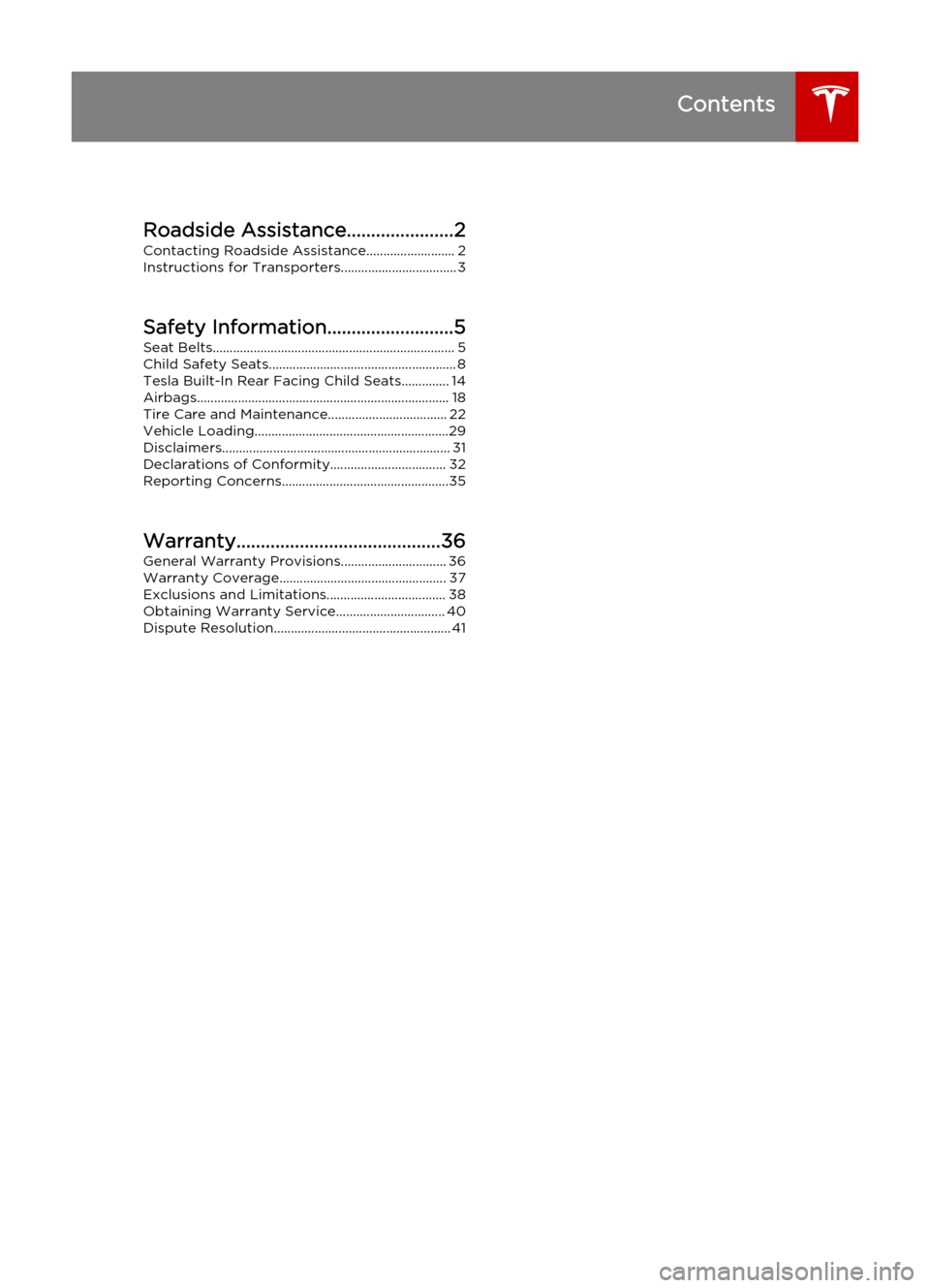
Roadside Assistance......................2Contacting Roadside Assistance.......................... 2
Instructions for Transporters.................................. 3
Use a Flatbed Only 3Disable Self-Leveling (air suspension vehicles only) 3Activate Tow Mode 3Connect the Tow Chain 4Pull Onto the Trailer and Secure the Wheels 4
Safety Information..........................5Seat Belts....................................................................... 5
Wearing Seat Belts 5Wearing Seat Belts When Pregnant 6Seat Belt Pre-tensioners 6Testing Seat Belts 7Seat Belt Warnings 7
Child Safety Seats....................................................... 8
Guidelines for Seating Children 8Choosing a Child Safety Seat 9Seating Larger Children 11Installing Child Safety Seats 11Installing Seat Belt Retained Child Seats 11Installing ISOFIXChild Seats 12Attaching Upper Tether Straps 12Testing a Child Safety Seat 13Warnings - Child Safety Seats 13
Tesla Built-In Rear Facing Child Seats.............. 14
Usage Restrictions 14Opening 14Folding 15Seating a Child 16Warnings - Tesla Child Seats 17
Airbags.......................................................................... 18
Location of Airbags 18How the Airbags Work 19Types of Airbags 19Disabling the Passenger Front Airbags 20Inflation Effects 21Airbag Warning Indicator 21Airbag Warnings 21
Tire Care and Maintenance................................... 22
Maintaining Tire Pressures 22Inspecting and Maintaining Tires 23Replacing Tires and Wheels 24Using Tire Chains 25Tire Pressure Monitoring 25Understanding Tire Markings 27
Vehicle Loading.........................................................29
Load Capacity Labeling 29Calculating Load Limits 30Towing a Trailer 30Roof Racks 30
Disclaimers................................................................... 31
Vehicle Telematics/Data Recorders 31Quality Control 31
Declarations of Conformity.................................. 32
Key and Passive Unlocking System 32Tire Pressure Monitoring System 33Media Control Unit 33Radio Frequency Information 34
Reporting Concerns.................................................35
Contacting Tesla 35
Warranty..........................................36General Warranty Provisions............................... 36
Who is the Warrantor? 36What Vehicles are Covered? 36Multiple Warranty Conditions 36Limitations and Disclaimers 36Ownership Transfer 36Who Can Enforce this New Vehicle Limited Warranty? 37When Does the Warranty Period Begin and End? 37
Warranty Coverage................................................. 37
Basic Vehicle Limited Warranty 37Supplemental Restraint System Limited Warranty 37Battery and Drive Unit Limited Warranty 38
Exclusions and Limitations................................... 38
Warranty Limitations 38Additional Limitations and Exclusions 39Voided Warranty 40Damages 40
Obtaining Warranty Service................................ 40
Payment of Tax for Repairs 41Reasonable Time for Repairs 41Roadside Assistance (Japan) 41Modifications and Waivers 41
Dispute Resolution.................................................... 41Contents
Page 7 of 96
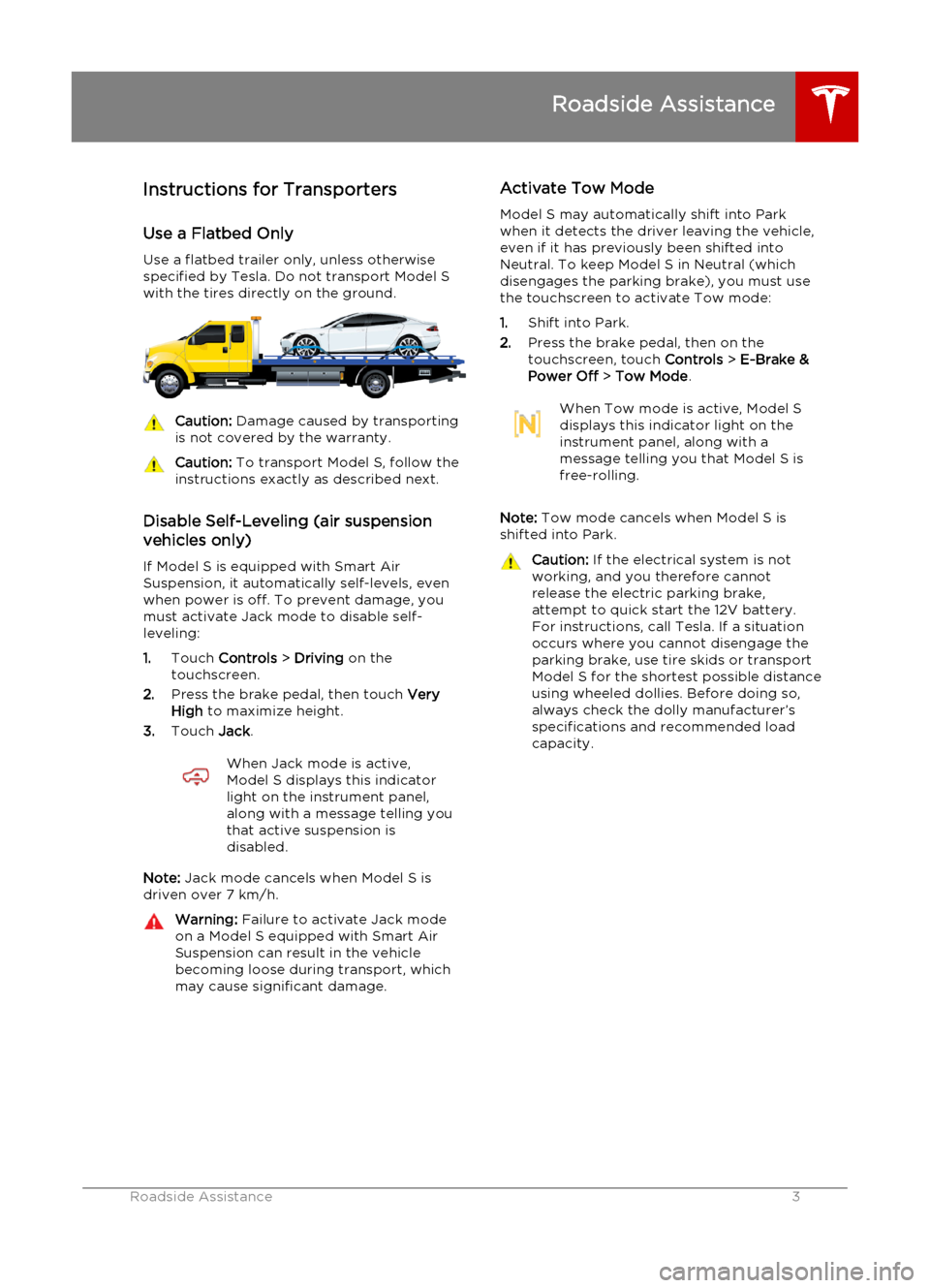
Instructions for Transporters
Use a Flatbed Only
Use a flatbed trailer only, unless otherwise specified by Tesla. Do not transport Model Swith the tires directly on the ground.Caution: Damage caused by transporting
is not covered by the warranty.Caution: To transport Model S, follow the
instructions exactly as described next.
Disable Self-Leveling (air suspension
vehicles only)
If Model S is equipped with Smart Air Suspension, it automatically self-levels, evenwhen power is off. To prevent damage, youmust activate Jack mode to disable self-
leveling:
1. Touch Controls > Driving on the
touchscreen.
2. Press the brake pedal, then touch Very
High to maximize height.
3. Touch Jack.
When Jack mode is active,
Model S displays this indicator
light on the instrument panel,
along with a message telling you
that active suspension is
disabled.
Note: Jack mode cancels when Model S is
driven over 7 km/h.
Warning: Failure to activate Jack mode
on a Model S equipped with Smart Air
Suspension can result in the vehicle becoming loose during transport, which
may cause significant damage.Activate Tow Mode
Model S may automatically shift into Park
when it detects the driver leaving the vehicle, even if it has previously been shifted intoNeutral. To keep Model S in Neutral (which
disengages the parking brake), you must use
the touchscreen to activate Tow mode:
1. Shift into Park.
2. Press the brake pedal, then on the
touchscreen, touch Controls > E-Brake &
Power Off > Tow Mode .When Tow mode is active, Model S
displays this indicator light on the
instrument panel, along with a
message telling you that Model S is
free-rolling.
Note: Tow mode cancels when Model S is
shifted into Park.
Caution: If the electrical system is not
working, and you therefore cannot
release the electric parking brake,
attempt to quick start the 12V battery.
For instructions, call Tesla. If a situation
occurs where you cannot disengage the
parking brake, use tire skids or transport
Model S for the shortest possible distance
using wheeled dollies. Before doing so,
always check the dolly manufacturer’s specifications and recommended load
capacity.
Roadside Assistance
Roadside Assistance3
Page 8 of 96
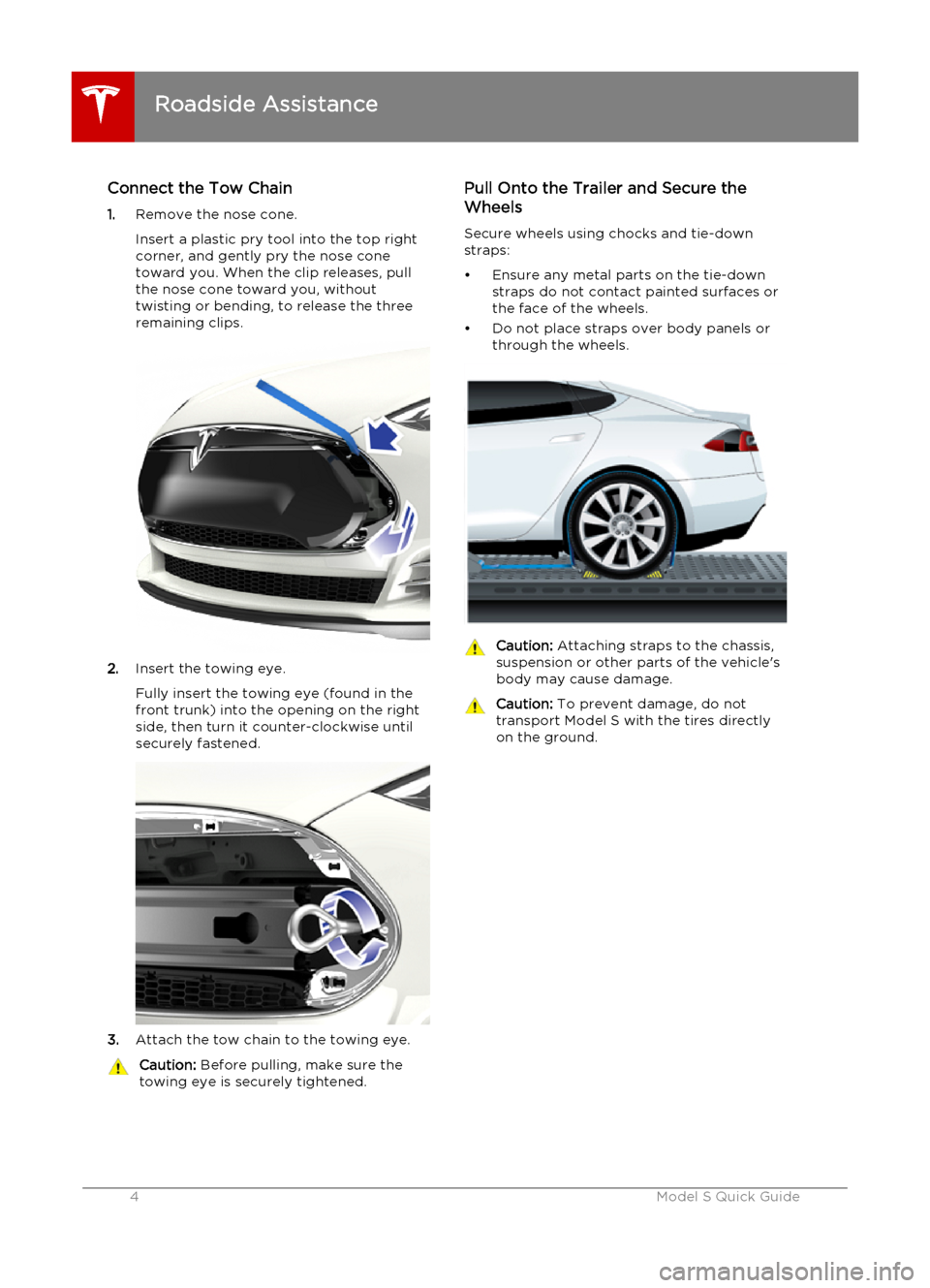
Connect the Tow Chain
1. Remove the nose cone.
Insert a plastic pry tool into the top right
corner, and gently pry the nose cone toward you. When the clip releases, pull
the nose cone toward you, without
twisting or bending, to release the three remaining clips.
2. Insert the towing eye.
Fully insert the towing eye (found in the
front trunk) into the opening on the right
side, then turn it counter-clockwise until securely fastened.
3. Attach the tow chain to the towing eye.
Caution:
Before pulling, make sure the
towing eye is securely tightened.Pull Onto the Trailer and Secure the
Wheels
Secure wheels using chocks and tie-down
straps:
• Ensure any metal parts on the tie-down straps do not contact painted surfaces orthe face of the wheels.
• Do not place straps over body panels or through the wheels.Caution: Attaching straps to the chassis,
suspension or other parts of the vehicle's
body may cause damage.Caution: To prevent damage, do not
transport Model S with the tires directly
on the ground.
Roadside Assistance
4Model S Quick Guide
Page 9 of 96
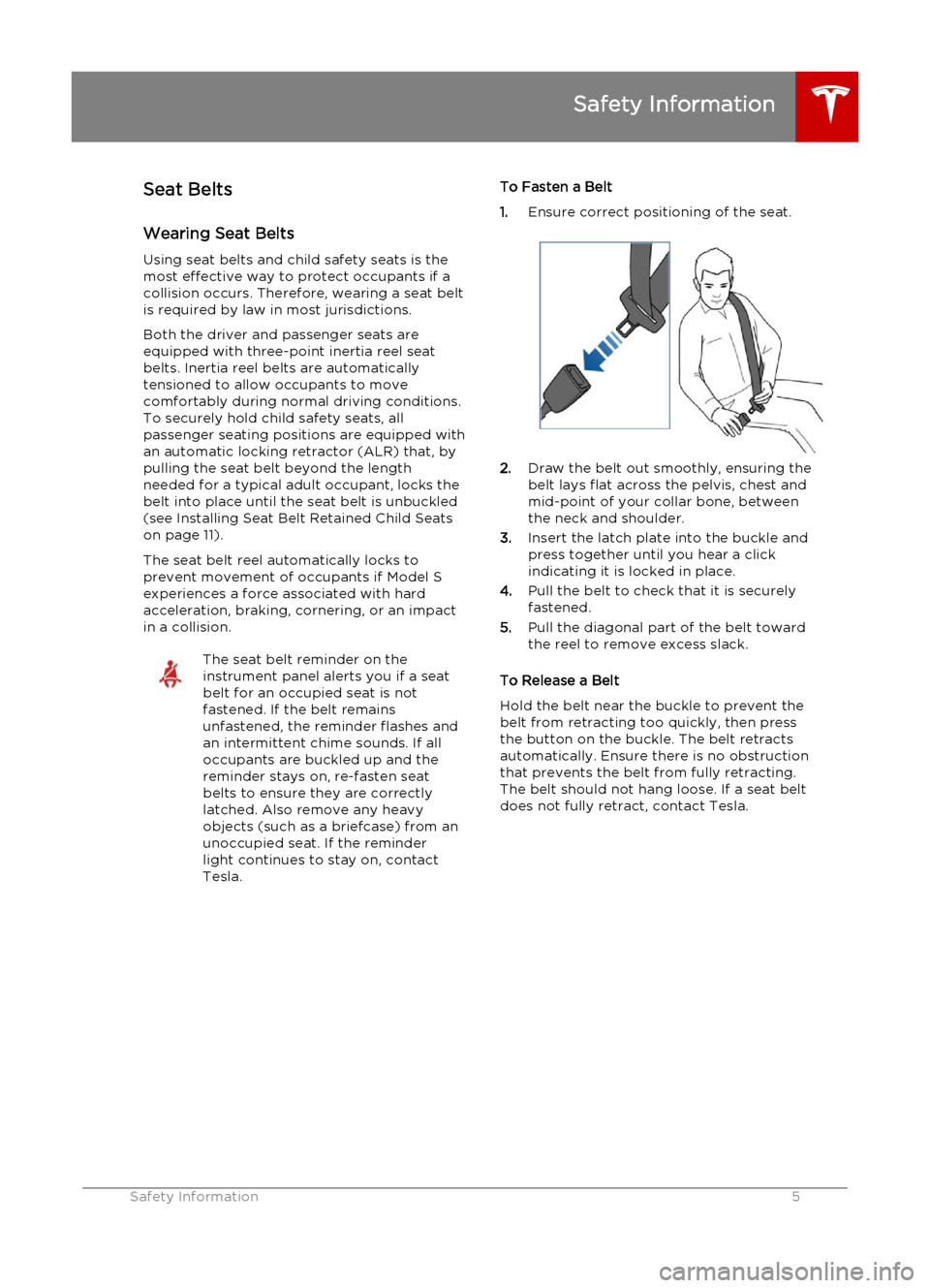
Seat BeltsWearing Seat Belts
Using seat belts and child safety seats is the
most effective way to protect occupants if a
collision occurs. Therefore, wearing a seat belt
is required by law in most jurisdictions.
Both the driver and passenger seats are equipped with three-point inertia reel seatbelts. Inertia reel belts are automatically
tensioned to allow occupants to move
comfortably during normal driving conditions.
To securely hold child safety seats, all
passenger seating positions are equipped with an automatic locking retractor (ALR) that, by
pulling the seat belt beyond the length
needed for a typical adult occupant, locks the belt into place until the seat belt is unbuckled
(see Installing Seat Belt Retained Child Seats
on page 11).
The seat belt reel automatically locks to prevent movement of occupants if Model S
experiences a force associated with hard
acceleration, braking, cornering, or an impact in a collision.The seat belt reminder on the
instrument panel alerts you if a seat
belt for an occupied seat is not
fastened. If the belt remains
unfastened, the reminder flashes and
an intermittent chime sounds. If all
occupants are buckled up and the
reminder stays on, re-fasten seat
belts to ensure they are correctly
latched. Also remove any heavy
objects (such as a briefcase) from an
unoccupied seat. If the reminder
light continues to stay on, contact
Tesla.To Fasten a Belt
1. Ensure correct positioning of the seat.
2.
Draw the belt out smoothly, ensuring the
belt lays flat across the pelvis, chest and
mid-point of your collar bone, between
the neck and shoulder.
3. Insert the latch plate into the buckle and
press together until you hear a click indicating it is locked in place.
4. Pull the belt to check that it is securely
fastened.
5. Pull the diagonal part of the belt toward
the reel to remove excess slack.
To Release a Belt
Hold the belt near the buckle to prevent the
belt from retracting too quickly, then press
the button on the buckle. The belt retracts
automatically. Ensure there is no obstruction
that prevents the belt from fully retracting.
The belt should not hang loose. If a seat belt does not fully retract, contact Tesla.
Safety Information
Safety Information5
Page 18 of 96
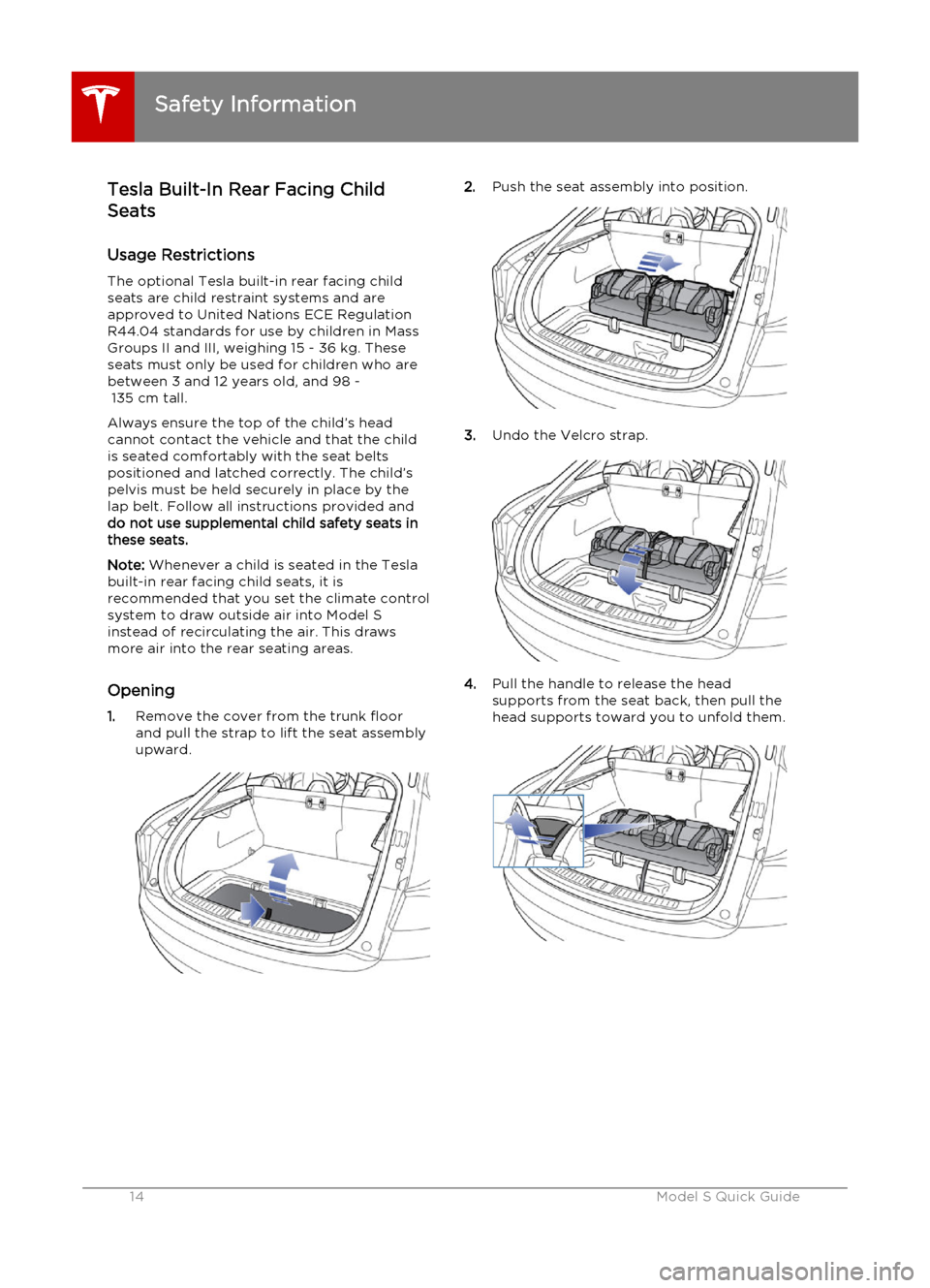
Tesla Built-In Rear Facing Child
Seats
Usage Restrictions
The optional Tesla built-in rear facing child
seats are child restraint systems and are approved to United Nations ECE Regulation
R44.04 standards for use by children in Mass
Groups II and III, weighing 15 - 36 kg. These
seats must only be used for children who are
between 3 and 12 years old, and 98 -
135 cm tall.
Always ensure the top of the child’s head cannot contact the vehicle and that the child
is seated comfortably with the seat belts
positioned and latched correctly. The child’s
pelvis must be held securely in place by the
lap belt. Follow all instructions provided and
do not use supplemental child safety seats in
these seats.
Note: Whenever a child is seated in the Tesla
built-in rear facing child seats, it is
recommended that you set the climate control
system to draw outside air into Model S
instead of recirculating the air. This draws
more air into the rear seating areas.
Opening 1. Remove the cover from the trunk floor
and pull the strap to lift the seat assembly upward.2. Push the seat assembly into position.
3.Undo the Velcro strap.
4.Pull the handle to release the head
supports from the seat back, then pull the
head supports toward you to unfold them.
Safety Information
14Model S Quick Guide
Page 19 of 96
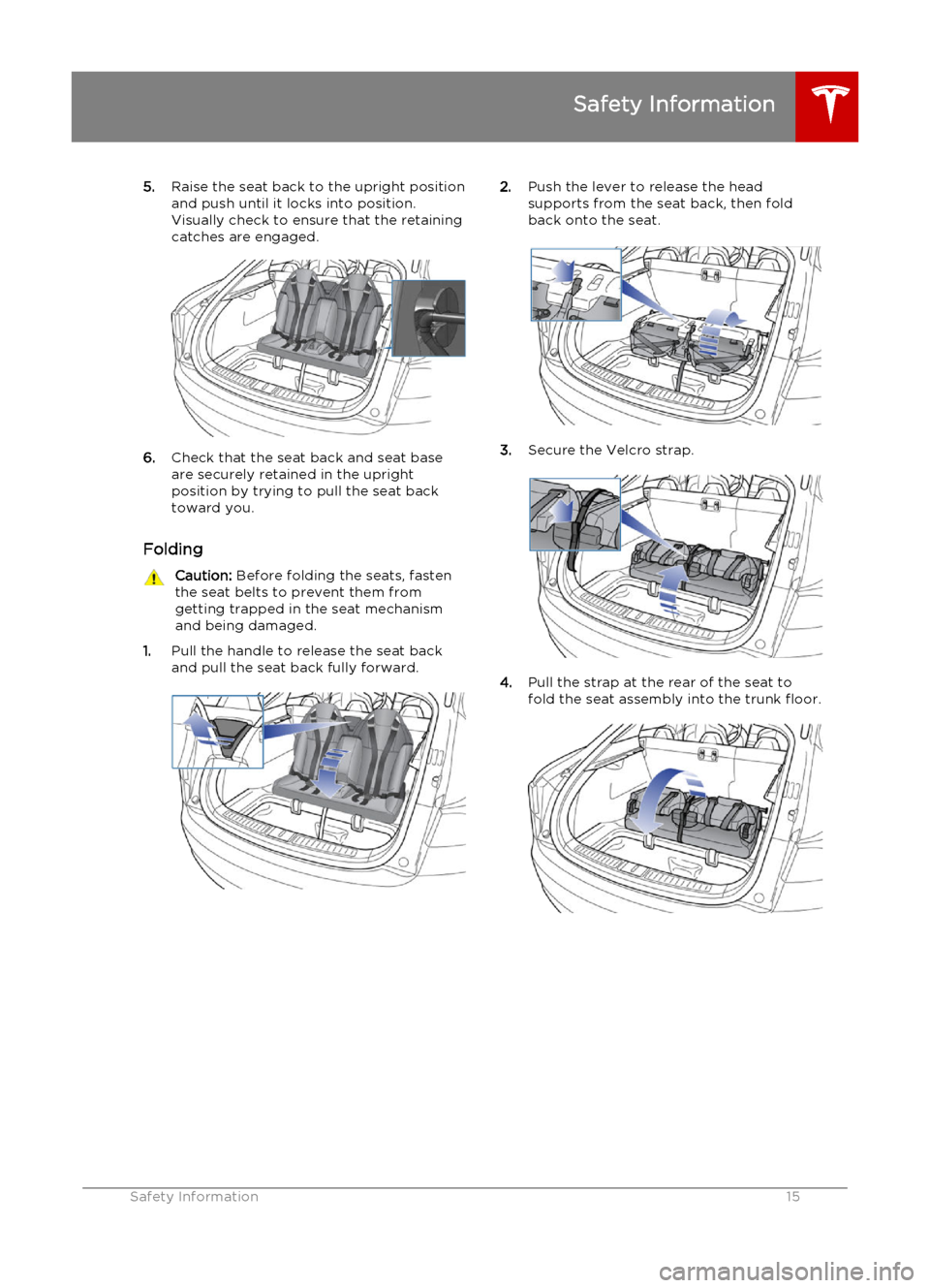
5.Raise the seat back to the upright position
and push until it locks into position.
Visually check to ensure that the retaining catches are engaged.
6. Check that the seat back and seat base
are securely retained in the upright
position by trying to pull the seat back toward you.
Folding
Caution: Before folding the seats, fasten
the seat belts to prevent them from
getting trapped in the seat mechanism and being damaged.
1. Pull the handle to release the seat back
and pull the seat back fully forward.
2. Push the lever to release the head
supports from the seat back, then fold
back onto the seat.
3. Secure the Velcro strap.
4.Pull the strap at the rear of the seat to
fold the seat assembly into the trunk floor.
Safety Information
Safety Information15
Page 21 of 96
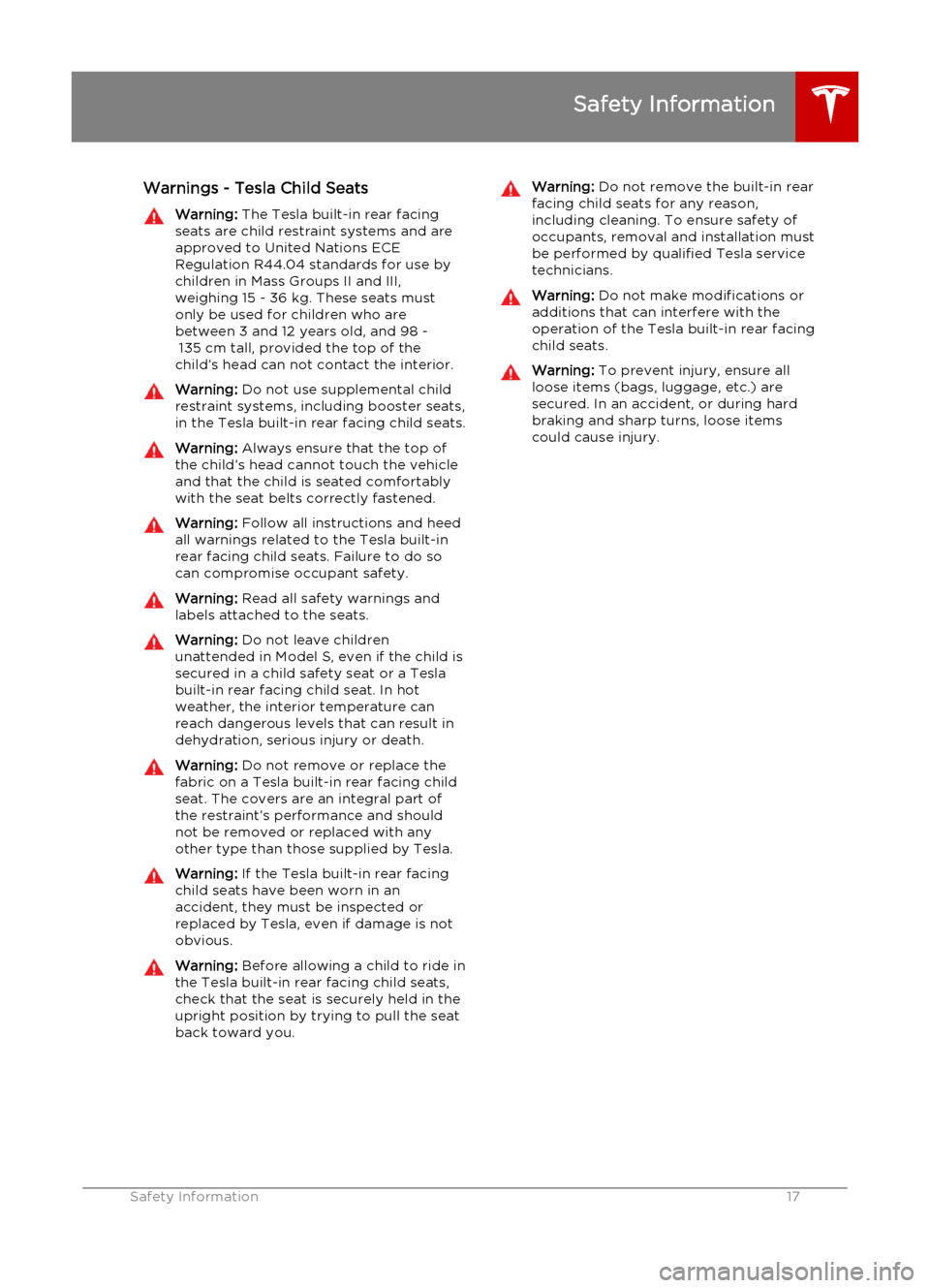
Warnings - Tesla Child SeatsWarning: The Tesla built-in rear facing
seats are child restraint systems and are approved to United Nations ECE
Regulation R44.04 standards for use by children in Mass Groups II and III,
weighing 15 - 36 kg. These seats must
only be used for children who are
between 3 and 12 years old, and 98 -
135 cm tall, provided the top of the
child’s head can not contact the interior.Warning: Do not use supplemental child
restraint systems, including booster seats,
in the Tesla built-in rear facing child seats.Warning: Always ensure that the top of
the child’s head cannot touch the vehicle and that the child is seated comfortablywith the seat belts correctly fastened.Warning: Follow all instructions and heed
all warnings related to the Tesla built-in
rear facing child seats. Failure to do so
can compromise occupant safety.Warning: Read all safety warnings and
labels attached to the seats.Warning: Do not leave children
unattended in Model S, even if the child is secured in a child safety seat or a Tesla
built-in rear facing child seat. In hot
weather, the interior temperature can reach dangerous levels that can result in
dehydration, serious injury or death.Warning: Do not remove or replace the
fabric on a Tesla built-in rear facing child
seat. The covers are an integral part of the restraint’s performance and shouldnot be removed or replaced with any
other type than those supplied by Tesla.Warning: If the Tesla built-in rear facing
child seats have been worn in an
accident, they must be inspected or
replaced by Tesla, even if damage is not
obvious.Warning: Before allowing a child to ride in
the Tesla built-in rear facing child seats, check that the seat is securely held in theupright position by trying to pull the seat
back toward you.Warning: Do not remove the built-in rear
facing child seats for any reason,
including cleaning. To ensure safety of
occupants, removal and installation must
be performed by qualified Tesla service
technicians.Warning: Do not make modifications or
additions that can interfere with the
operation of the Tesla built-in rear facing
child seats.Warning: To prevent injury, ensure all
loose items (bags, luggage, etc.) are
secured. In an accident, or during hard
braking and sharp turns, loose items
could cause injury.
Safety Information
Safety Information17
Page 34 of 96
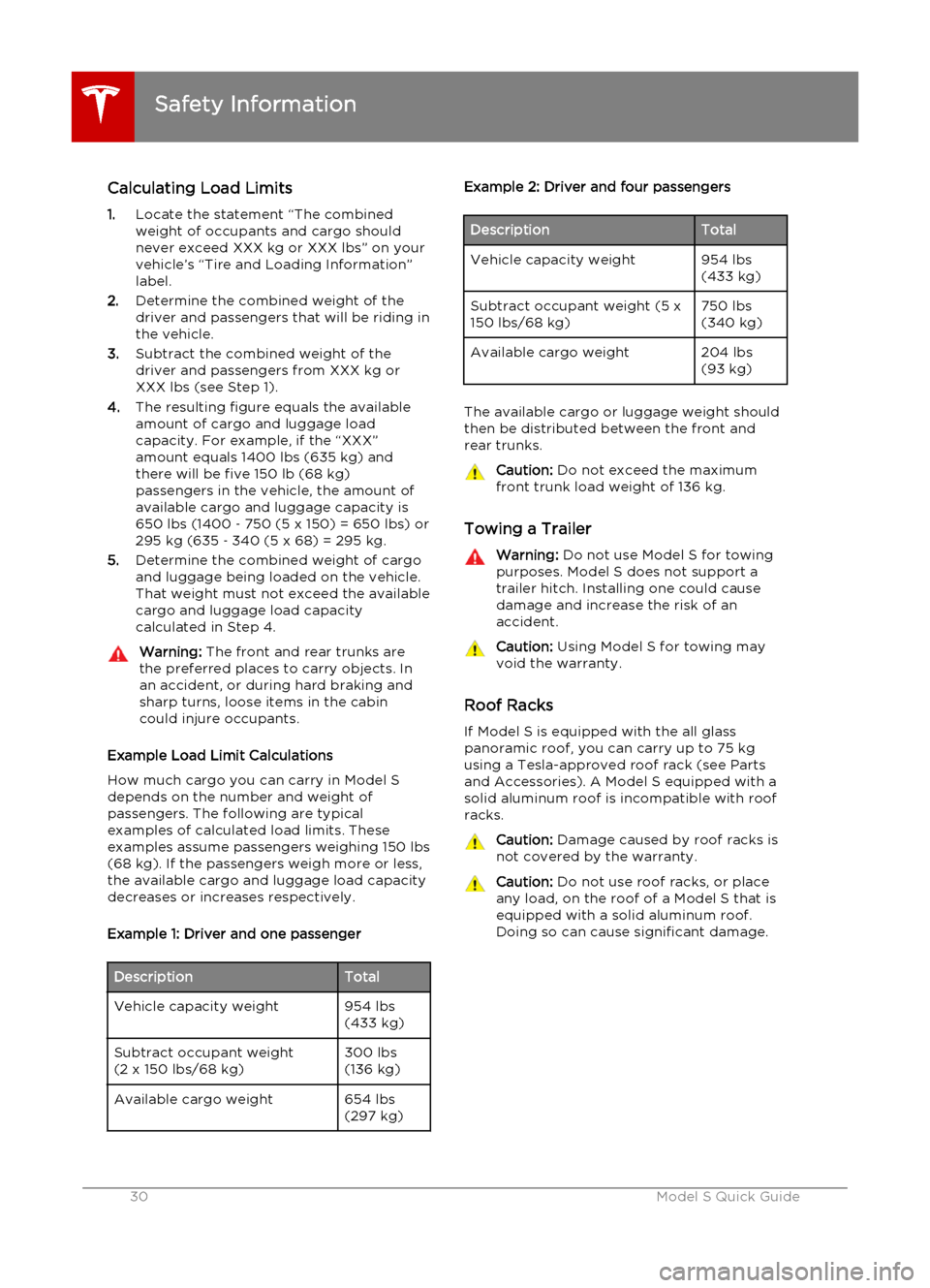
Calculating Load Limits
1. Locate the statement “The combined
weight of occupants and cargo should never exceed XXX kg or XXX lbs” on your
vehicle’s “Tire and Loading Information” label.
2. Determine the combined weight of the
driver and passengers that will be riding in
the vehicle.
3. Subtract the combined weight of the
driver and passengers from XXX kg or
XXX lbs (see Step 1).
4. The resulting figure equals the available
amount of cargo and luggage load
capacity. For example, if the “XXX”
amount equals 1400 lbs (635 kg) and there will be five 150 lb (68 kg)
passengers in the vehicle, the amount of
available cargo and luggage capacity is
650 lbs (1400 ‑ 750 (5 x 150) = 650 lbs) or
295 kg (635 ‑ 340 (5 x 68) = 295 kg.
5. Determine the combined weight of cargo
and luggage being loaded on the vehicle.
That weight must not exceed the available
cargo and luggage load capacity
calculated in Step 4.Warning: The front and rear trunks are
the preferred places to carry objects. In
an accident, or during hard braking and sharp turns, loose items in the cabin
could injure occupants.
Example Load Limit Calculations
How much cargo you can carry in Model S
depends on the number and weight of
passengers. The following are typical
examples of calculated load limits. These
examples assume passengers weighing 150 lbs (68 kg). If the passengers weigh more or less,
the available cargo and luggage load capacity decreases or increases respectively.
Example 1: Driver and one passenger
DescriptionTotalVehicle capacity weight954 lbs
(433 kg)Subtract occupant weight
(2 x 150 lbs/68 kg)300 lbs
(136 kg)Available cargo weight654 lbs
(297 kg)Example 2: Driver and four passengersDescriptionTotalVehicle capacity weight954 lbs
(433 kg)Subtract occupant weight (5 x
150 lbs/68 kg)750 lbs
(340 kg)Available cargo weight204 lbs
(93 kg)
The available cargo or luggage weight should
then be distributed between the front and
rear trunks.
Caution: Do not exceed the maximum
front trunk load weight of 136 kg.
Towing a Trailer
Warning: Do not use Model S for towing
purposes. Model S does not support a
trailer hitch. Installing one could cause
damage and increase the risk of an
accident.Caution: Using Model S for towing may
void the warranty.
Roof Racks
If Model S is equipped with the all glasspanoramic roof, you can carry up to 75 kgusing a Tesla-approved roof rack (see Partsand Accessories). A Model S equipped with a
solid aluminum roof is incompatible with roof
racks.
Caution: Damage caused by roof racks is
not covered by the warranty.Caution: Do not use roof racks, or place
any load, on the roof of a Model S that is equipped with a solid aluminum roof.Doing so can cause significant damage.
Safety Information
30Model S Quick Guide
Page 43 of 96
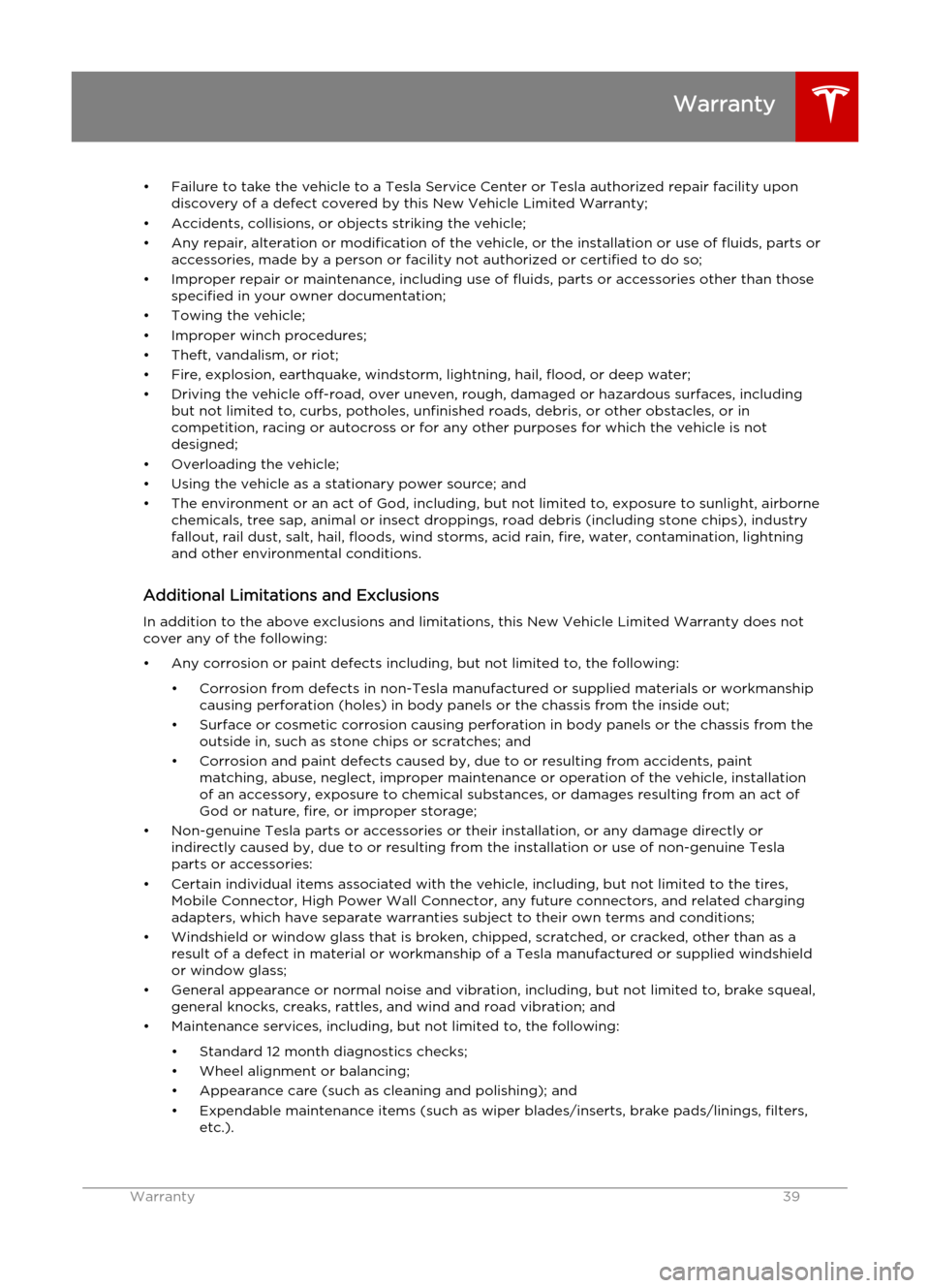
• Failure to take the vehicle to a Tesla Service Center or Tesla authorized repair facility upondiscovery of a defect covered by this New Vehicle Limited Warranty;
• Accidents, collisions, or objects striking the vehicle; • Any repair, alteration or modification of the vehicle, or the installation or use of fluids, parts or accessories, made by a person or facility not authorized or certified to do so;
• Improper repair or maintenance, including use of fluids, parts or accessories other than those specified in your owner documentation;
• Towing the vehicle;
• Improper winch procedures;
• Theft, vandalism, or riot; • Fire, explosion, earthquake, windstorm, lightning, hail, flood, or deep water;
• Driving the vehicle off-road, over uneven, rough, damaged or hazardous surfaces, including but not limited to, curbs, potholes, unfinished roads, debris, or other obstacles, or in
competition, racing or autocross or for any other purposes for which the vehicle is not
designed;
• Overloading the vehicle;
• Using the vehicle as a stationary power source; and
• The environment or an act of God, including, but not limited to, exposure to sunlight, airborne chemicals, tree sap, animal or insect droppings, road debris (including stone chips), industryfallout, rail dust, salt, hail, floods, wind storms, acid rain, fire, water, contamination, lightning
and other environmental conditions.
Additional Limitations and Exclusions
In addition to the above exclusions and limitations, this New Vehicle Limited Warranty does not
cover any of the following:
• Any corrosion or paint defects including, but not limited to, the following: • Corrosion from defects in non-Tesla manufactured or supplied materials or workmanship causing perforation (holes) in body panels or the chassis from the inside out;
• Surface or cosmetic corrosion causing perforation in body panels or the chassis from the outside in, such as stone chips or scratches; and
• Corrosion and paint defects caused by, due to or resulting from accidents, paint matching, abuse, neglect, improper maintenance or operation of the vehicle, installation
of an accessory, exposure to chemical substances, or damages resulting from an act of
God or nature, fire, or improper storage;
• Non-genuine Tesla parts or accessories or their installation, or any damage directly or indirectly caused by, due to or resulting from the installation or use of non-genuine Teslaparts or accessories:
• Certain individual items associated with the vehicle, including, but not limited to the tires, Mobile Connector, High Power Wall Connector, any future connectors, and related charging
adapters, which have separate warranties subject to their own terms and conditions;
• Windshield or window glass that is broken, chipped, scratched, or cracked, other than as a result of a defect in material or workmanship of a Tesla manufactured or supplied windshieldor window glass;
• General appearance or normal noise and vibration, including, but not limited to, brake squeal, general knocks, creaks, rattles, and wind and road vibration; and
• Maintenance services, including, but not limited to, the following:
• Standard 12 month diagnostics checks;• Wheel alignment or balancing;
• Appearance care (such as cleaning and polishing); and • Expendable maintenance items (such as wiper blades/inserts, brake pads/linings, filters, etc.).
Warranty
Warranty39
Page 44 of 96
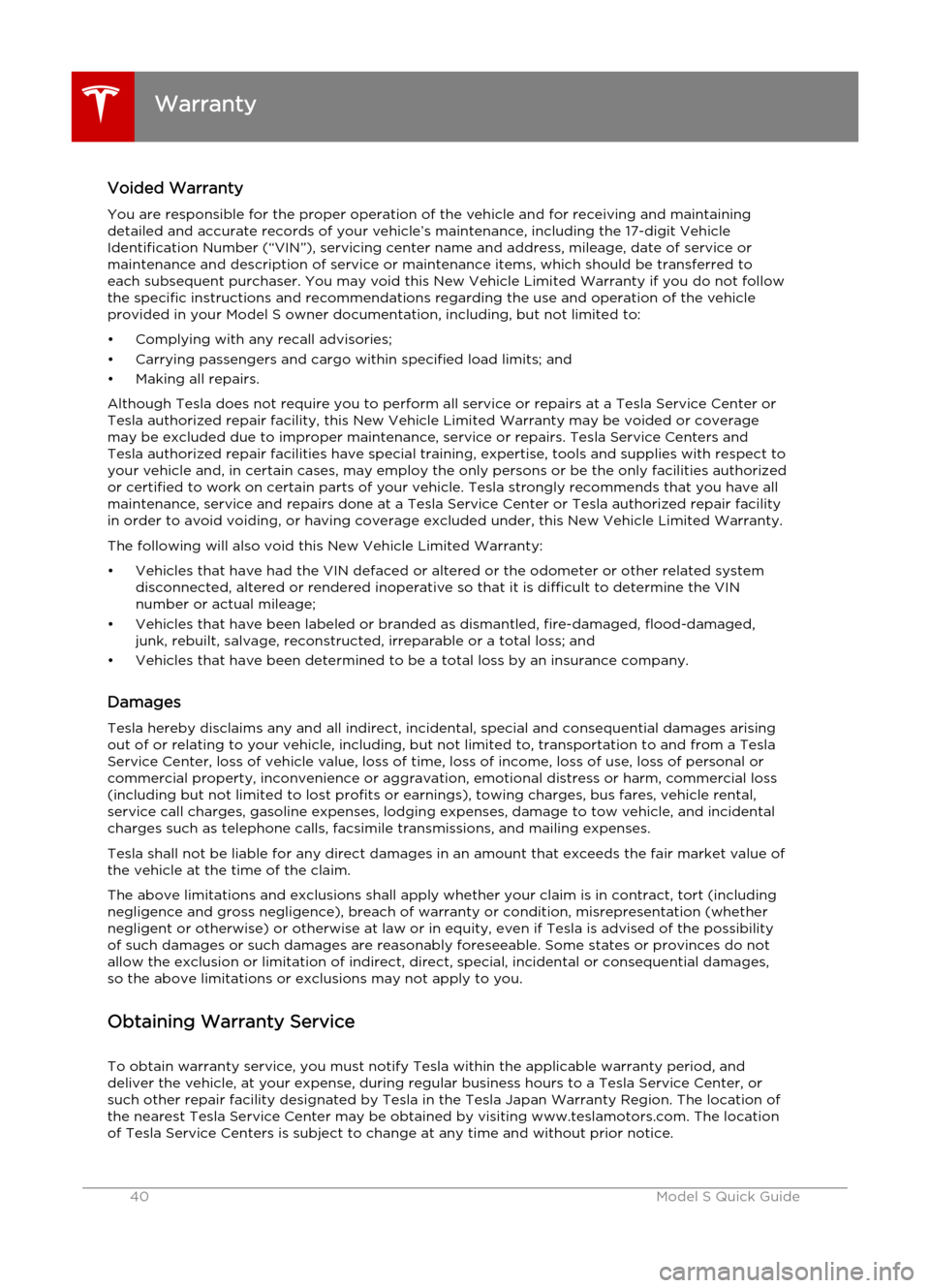
Voided Warranty
You are responsible for the proper operation of the vehicle and for receiving and maintaining detailed and accurate records of your vehicle’s maintenance, including the 17-digit Vehicle
Identification Number (“VIN”), servicing center name and address, mileage, date of service or
maintenance and description of service or maintenance items, which should be transferred to
each subsequent purchaser. You may void this New Vehicle Limited Warranty if you do not follow
the specific instructions and recommendations regarding the use and operation of the vehicle
provided in your Model S owner documentation, including, but not limited to:
• Complying with any recall advisories; • Carrying passengers and cargo within specified load limits; and• Making all repairs.
Although Tesla does not require you to perform all service or repairs at a Tesla Service Center or
Tesla authorized repair facility, this New Vehicle Limited Warranty may be voided or coverage
may be excluded due to improper maintenance, service or repairs. Tesla Service Centers and
Tesla authorized repair facilities have special training, expertise, tools and supplies with respect to
your vehicle and, in certain cases, may employ the only persons or be the only facilities authorized
or certified to work on certain parts of your vehicle. Tesla strongly recommends that you have all
maintenance, service and repairs done at a Tesla Service Center or Tesla authorized repair facility
in order to avoid voiding, or having coverage excluded under, this New Vehicle Limited Warranty.
The following will also void this New Vehicle Limited Warranty:
• Vehicles that have had the VIN defaced or altered or the odometer or other related system disconnected, altered or rendered inoperative so that it is difficult to determine the VINnumber or actual mileage;
• Vehicles that have been labeled or branded as dismantled, fire-damaged, flood-damaged, junk, rebuilt, salvage, reconstructed, irreparable or a total loss; and
• Vehicles that have been determined to be a total loss by an insurance company.
Damages Tesla hereby disclaims any and all indirect, incidental, special and consequential damages arisingout of or relating to your vehicle, including, but not limited to, transportation to and from a Tesla Service Center, loss of vehicle value, loss of time, loss of income, loss of use, loss of personal orcommercial property, inconvenience or aggravation, emotional distress or harm, commercial loss
(including but not limited to lost profits or earnings), towing charges, bus fares, vehicle rental,
service call charges, gasoline expenses, lodging expenses, damage to tow vehicle, and incidental
charges such as telephone calls, facsimile transmissions, and mailing expenses.
Tesla shall not be liable for any direct damages in an amount that exceeds the fair market value of
the vehicle at the time of the claim.
The above limitations and exclusions shall apply whether your claim is in contract, tort (including
negligence and gross negligence), breach of warranty or condition, misrepresentation (whether
negligent or otherwise) or otherwise at law or in equity, even if Tesla is advised of the possibility of such damages or such damages are reasonably foreseeable. Some states or provinces do not
allow the exclusion or limitation of indirect, direct, special, incidental or consequential damages,
so the above limitations or exclusions may not apply to you.
Obtaining Warranty Service To obtain warranty service, you must notify Tesla within the applicable warranty period, and
deliver the vehicle, at your expense, during regular business hours to a Tesla Service Center, or
such other repair facility designated by Tesla in the Tesla Japan Warranty Region. The location of the nearest Tesla Service Center may be obtained by visiting www.teslamotors.com. The location
of Tesla Service Centers is subject to change at any time and without prior notice.
Warranty
40Model S Quick Guide